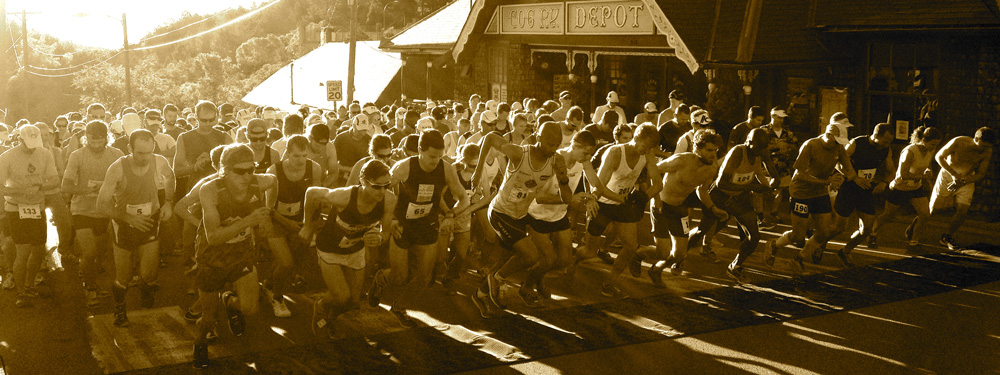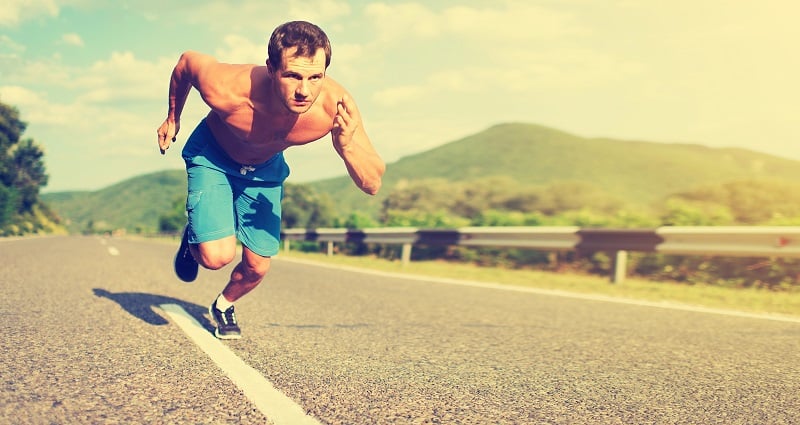Running outdoor is awesome. It will keep you sane, healthy and will get you into the best shape of your life.
It’s also awesome for the lungs and a great way to soak up some vitamin D.
But there’s a dark side to it, especially if you run in a city near or around traffic. The number of fatalities among pedestrians (runners included) caused by motorized vehicles is quite staggering.
That’s why most outdoor sports—especially running—can at times be dangerous.
Fret no more.
In today’s post, I’ll share the go-to guidelines on staying safe on the roads while running.
Some of them may seem obvious, but it can only take one blasé second for a disaster to happen.
Safety is paramount, and taking a few precautions will not compromise your running routine. It will, in fact, invigorate it.
So are you excited? Then here we go…
The Stats
The National Highway Traffic Safety Administration reported that a pedestrian is killed every 88 minutes in traffic accidents. That amounts to roughly 16 people per day and almost 6,000 each year.
That’s not the whole story. Surveys also show that about 140,000 pedestrians were treated in hospitals for nonfatal crash-related injuries every year.
Although I couldn’t find any specific related to the number of fatalities among the running population, I bet it’s a big number.
To overcome this reason, to be proactive and take the right precautions and steps while running near the road near traffic.
Following these road safety rules and some old common sense can help keep you safe (and alive) when you hit the streets for a run.
Some of the advice I’m sharing with you today is something you probably heard a thousand times (look both ways when you cross the street, for instance), but that does not make them less relevant.
Cross Properly
Cross at areas specified for pedestrian crossings. These are found at road intersections—where drivers expect pedestrians.
If you a crosswalk is unavailable, then find the safest and most well-lit spot on the road to cross.
Remember to check for vehicles coming from multiple directions and lanes before trying to cross at an intersection.
Drivers Can’t See you
Run with the assumption that drivers can’t see you and that you have the responsibility to navigate through while keeping, at least, a three- to five-foot distance between you and any vehicle.
Most of the time, drivers are distracted, listening to the radio, only paying attention to other drivers, or even talking on the phone and being drunk. So they won’t be paying attention to a runner.
For more safety, stick your hand out to drivers that you want to cross. Also, be sure to use hand signals when changing directions.
Look Both Ways
Crossing the streets can be fraught with danger. And the streets regulated by stop signs are the most horrible for runners.
I hate to sound like a broken record, be sure to look both ways before you cross the street—just like what mother used to hammer on you when you were a child.
Make Eye contact
Before you cross the road, make eye contact with the driver and be sure they acknowledge your right-of-way both prior to stepping before a moving vehicle and when moving through an intersection.
If you and a car are both coming up to an intersection, stop and let the car go first. You are not the Flash, and you will never win that race unless the driver is cruising along really slow.
At a stop sign or light, wait for the driver to give you the sign—then acknowledge with your own civil way. This act will encourage the drive to feel more disposed to repeat the kind gesture for the next runner and pedestrian.
And for good measures, make sure to steer clear of the roads and do the bulk of your running on trail paths, parks, and sidewalks, avoiding cars as much as possible.

Pay Attention to Intersections
Don’t assume you’re out of harm’s way just because the walk-in sign is “On.”
A driver might take a swift turn into the crosswalk or may even run the light. That happens all the time. Some drivers do it on purpose, but most are too distracted even to notice.
Additional Resource – Here’s how to protect yourself from dogs
Use The Sidewalk
You are prone to accidents if you’re running on the road near cars, trucks, and other vehicles. Therefore, make sure to run on the sidewalk if one is available.
That said, there are a few exceptions to this rule. These include:
- When running on a quiet and safe residential road
- During an organized race
- Roads on which traffic is almost nonexistent
- Roads without sidewalks
- Frozen sidewalks that may be hazardous and/or slippery.
- Whenever your gut tells you otherwise.
Face Traffic
In case there is no sidewalk, then run facing oncoming traffic better see oncoming cars, and the drivers will see you more clearly, too.
This can help you prevent traffic-related accidents, especially if you run at night or in the early morning.
The only exception to this rule is when you’re about to reach a blind corner or bend where visibility is poor. Keep in mind that if you cannot see around it, neither is the driver coming the other way.
When it’s the case, cross to the right side of the road, and stay as far to the right as possible, keep your music off, and pay attention to what’s happening around you.
Do not, under any circumstance, run down the middle of the road.
Additional resource – How to run in the city
Don’t Try to Outpace a Vehicle
Even if you are an elite sprinter, you are no match for the size and speed of a vehicle. The truth is, motored vehicles are faster than you. Usain Bolt, the fastest man alive, cannot outsprint a car cruising at no more than 30 to 40 mph—the speed limits in most cities.
The fact is, when a vehicle and a human being collide, there is no surprise to which one stands more to lose.
If you and a motored vehicle are both approaching an intersection, stop and let the vehicle pass first.
When in doubt, step aside or stop and wait. Do not be another traffic statistic.
Be Shiny
If you are running at night or at dusk when visibility is poor, make sure to be seen by wearing high-visibility, brightly colored clothing, even neon.
This reflective material can be a real life saver.
If you don’t own reflective clothing, wear light-colored clothing or a lightweight reflective vest.
You should also consider using a headlamp or handheld light—sure, they do look dorky, but safety comes first— so you can see where you are running, and also let cars and other people (and creatures) know where you are.
Additional Resource – Here’s the full guide to running watches
Have Awareness
The cardinal rule runners need to abide by to stay safe is to pay attention.
With earbuds glued to your ears, lost in thought, or distracted by the noises around you, you may miss the fact that you’ve just stepped into a bustling intersection. Make sure the earbuds are not too loud so you can still hear your surroundings.
Stay attuned to the surrounding noises, be it a honking horn, the growl of an engine, the sound of an approaching vehicle, or a barking dog—these sounds are potential red flags to keep an ear for.
Even if you are running in a secluded area where drivers pose no threat, be aware of others, especially cyclists, runners, walkers, and the rest.
Also, keep an eye for early birds, night owls, dogs, and other animals you may cross paths with. Use a repellant if you’re running in bushy or dark areas. Save yourself from scratches.
Have Some Manners
Before you try passing a runner or cyclists (if you are that fast), make some noise and let them know on which side you are trying to pass them by.
No one likes to be startled when exercising, so treat others the way you want them to treat you.
Don’t Run with Earphones
Of course, I’m not against getting into the “zone, ” but if it’s hindering your awareness of where you’re, the so-called zone can do more harm than good.
I often run with my earphones, but I also make sure to take the music down a notch (it’s also good for ear health), and in case I sense any danger, or I’m in a secluded area, I only use one earpiece and switch ears throughout the run.
The pumping sound of music in your ears will definitely dull your senses, making you less likely to hear an impending attacker, and it also kills your reaction time, rendering you helpless in the case of a surprise incident.
Still keen on music?
Consider opting for a pair of open-ear headphones.
These usually use bone conduction to create mini vibrations, sending sounds through the cheekbones directly to your brain (your inner ear, specifically). This allows for better situational awareness and comfort. You’re getting the best of both worlds.
Avoid Dark Time Runs
Do not hit the outdoors during the darker hours, especially at night.
Surveys show that about 70 percent of pedestrian fatalities occur at night, with 32 percent of all pedestrian fatalities taking place between 8 p.m. and 11:59 p.m.
If you must run in the dark, Whether you’re running early in the morning or late in the evening, wear high-visibility, brightly colored workout clothing and materials, such as sashes, armbands, jackets, and running shoes.
If you don’t have reflective clothing, then, at least, carry something light-colored, fluorescent, or bright in daylight conditions. Use a lightstick or headlamp if you have one.
Additional resource – Trail Running First Aid Kit
Carry Identification
Please, don’t be a John Smith or Jane Doe. Even though you already plan your route, it doesn’t guarantee complete safety. Bad things happen, sometimes.
As a rule of thumb, whenever you’re exercising outdoors, whether you’re running, biking, trekking, or power walking, make sure to carry a driver’s license and medical insurance card in your pocket or ID tag whenever you run alone
Most workout-oriented gear has small pouches for this very reason.
If you are wearing an ID tag, make sure it has at least three emergency contact numbers of people you rely on, as well as your medical information.
Or, at least, carry your cell phone with your ID and emergency contact list taped to its back.
Have Cash on
Along with an ID tag, make sure also to have some cash or a credit card in your pocket or shoe.
You will never know what purpose this cash may serve.
The cash will also be needed if you need to stop and get first aid supplies in case of emergency, God forbid.
Carry Your Phone
I don’t always run with my Smartphone (too distracting), but you just have to have a phone with you in case something bad happened—especially nowadays where street payphones are a dying breed.
Most phones have GPS and can help you navigate your way home in case you get lost. Plus, you can always use it to call a friend or a cab in the event of an emergency, for instance, if you get injured or you got embroiled in an accident.
Be Boring
Female runners pay particular attention here.
Yeah, of course, diamonds are a woman’s best friend, as the saying goes, but not during your runs. The fact, they will only attract attention, the wrong type of attention.
Leave your fancy rings, earrings, watch, whatever, etc., back at home. Do not attract any unwanted attention. Be as boring as possible. The other reason, sweat may damage your jewelry, so better keep it safe at home.
Trust Your Guts
In the end, your gut feeling might be all you need to stay safe on the road.
If you feel something wrong with a runner, a person, a driver, a place, a setting, then you shouldn’t discount these gut feelings. Trust your instinct and run in the other direction or simply stop in somewhere crowded to ask for help.
Never underestimate them. They got you so far, and they have your back—as long as you are willing to listen and behave accordingly.
Conclusion
There you have it! If your goal is to stay while running on road, the above traffic rules for runners should be enough to help you achieve it. It’s just a matter of putting them into practice.
Please feel free to leave your comments and questions in the section below.
In the meantime, thank you for dropping by.
Keep training strong.
David D.

















